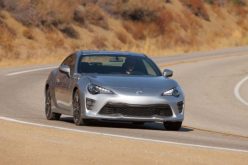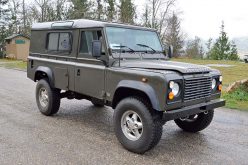Chances are that if you’ve every driven anywhere, watched any political drama, seen any rap video or had a look at the livery car line-up at the airport, you’ve seen a Chevrolet Tahoe. It has become one of the most recognized vehicles on North American roads – especially parked just on the shoulder, with a push bar on the front – which is a feat because it is and has always been a pickup truck-based, ladder-framed basic two-box shape and until the latest model you see here, has had pretty tame styling. It has legions of dedicated fans, however, that have lent a level of brand equity to its name that you really can’t buy or pay for.
For 2021, meanwhile, the Tahoe is all-new with a host of new features, with the goal in mind to make this popular SUV even more attractive to buyers.
It starts with the styling – actually, more specifically, it starts with that grille and those headlights. The headlights themselves are slim to the point they actually kind of remind of the items found on the Chevrolet Camaro, while the DRLs are boomerang-shaped and coupled with the grille, the whole shebang is actually shared with the Silverado 1500 pickup.
Other nice details include my truck’s 22-in. wheels (base Tahoes get 18s; 20s are also available), though the exact style seen here is actually a – deep breath — $4,165 option. That’s $4,165 just for the wheels as they don’t come as part of a package with other features. They look great, but that’s a big cost.
There are also some nice “Easter Egg”-type details as well, such as the “Chevrolet” scripting integrated into the left brake light, while the right light assembly features a subtle Bowtie logo. I also like the “High Country” script stamped into the grille as well as the Bowtie logo that appears just below the spot under which you’re to wave your foot to activate the tailgate – which, I have do admit, didn’t always work. That tailgate, by the way, is a two-part affair in that you can either open up the entire door, or just the rear window so you don’t risk losing items upon opening the hatch.
Inside, my truck’s High Country trim means “Mocha” (read “light brown;” I prefer “gingerbread” or “baseball glove”) leather interior that looks fantastic – brown leather can go very wrong in the car world, but they’ve nailed it here. I’m less enamoured with the black plastic surrounding the climate control and infotainment controls on the centre stack, and even less so with the way the leather surrounding either side of the transmission tunnel by the knees isn’t snug enough, making for some cheap-feeling flex if you bump a knee. Not that that happens often, but just knowing that issue exists is enough to leave a bad taste in the mouth and since it happens either side of the trans tunnel, it seems less a fluke, and more an actual design flaw.
The big 10.2-in. infotainment screen above all that, though, is all aces and it’s compatible with Android and wireless Apple CarPlay, which is right on and backed up by a massive wireless charge pad that looks large enough for a tablet, let alone a smartphone. Even Chevy’s native interface isn’t too bad, but I used CarPlay most of the time. The gauge cluster is a little tame-looking, but the TFT display between the two main gauges displays the most pertinent information succinctly and sharply, and can be easily navigated with steering wheel buttons. Which, along with your cruise controls, voice activation controls and heated steering wheel button, is all you’ll find on the uncluttered wheel.
Speaking of displays: my tester also had a heads-up display I hardly ever used, but did note that it wasn’t obstructed by polarized sunglasses, which is nice. A tech feature I used plenty is the digital rear-view mirror, even if it’s a little too small considering it’s mounted to a pretty XL vehicle. It looks better suited for a compact crossover and I can only blame cost cutting measures for why we don’t see something larger in here.
Regardless of that, it does well to provide a wide-angled view out back and means you don’t have to worry about having tall rear passengers or packing your luggage too high because no matter what, the view out will always be the same.

I just don’t really see the point. Especially considering that if you leave it open, it makes it impossible to access the third row from between the second-row captain’s chairs, because the retracted storage unit is in the way.
Speaking of the third row: for 2021, it’s become a little more habitable thanks to another big innovation for the ’21 Tahoe: independent rear suspension, something the Tahoe’s main Ford Expedition competition has had for quite some time now.
The new suspension is packaged much smaller than the old solid axle setup, so it doesn’t infringe as much into the cabin making for easier loading and more rear-seat legroom. The result is actually a fairly usable third row thanks to the space provided, as well as features like two USB-C ports, cupholders and storage bins. The seat cushions are still a little on the thin side but that’s usually the case when it comes to three-row SUVs. They’re also easy to access thanks to a slide-and-tumble second row, as well as the aforementioned passage between the second-row captain’s chairs.
Not only does the new suspension make for more room inside, it also makes for a much smoother ride, especially when coupled with my tester’s air-side suspension/magnetic ride dampers (just like in a Corvette!) that can be adjusted to four ride heights. The Tahoe is still a body-on-frame truck, but you don’t get anywhere near the shuddering through the chassis over bumps that you used to. It also offers the highest ride height we’ve ever seen in a Tahoe when set to its highest setting. The bottom line is the ride in here is properly luxury-spec.
While the big new add in the power department for ’21 is the availability of a 3.0-litre Duramax diesel engine, the returning 5.3-litre and 6.2-litre (as seen here) V8s have now been blessed with Chevy’s Active Fuel Management system for better fuel economy. Power remains the same at 420 horsepower and 460 lb-ft of torque for the 6.2, but since it’s fed through a close-ratio 10-speed automatic transmission (your only choice for ’21), it feels almost more powerful than that. I never found myself wanting for more power, and while normally I’d say “if you want to tow, get the diesel” that’s not so obvious here as its 8,000 lb. tow rating means the diesel actually tows less then every other 4WD-equipped model. It will likely use less fuel while doing so but still; it definitely helps reinforce the qualities of the 6.2L V8.
It’s a smooth, torquey engine that reaches peak torque at 4,100 rpm, so coupled with that great transmission, forward progress is much less “lumbering” and much more “brisk.” Plus, it’s got a throaty growl that helps reinforce the feeling that it is a powertrain that will last a good, long while.
My, does it ever come at a cost, though. At its base, the High Country starts at almost $81,000 – or, about 30 grand more than what the 2WD Tahoe starts at – and that doesn’t even include that fantastic air suspension I had. That comes as part of the $5,805 High Country Deluxe package. That package, meanwhile, also adds adaptive cruise control which really should already be included on all High Countrys. Then you add those wheels and a few other bits, and you’re knocking on 95 grand. 95 thousand dollars for a Chevy Tahoe is a lot to spend and while there are Tahoe fans out there that won’t mind spending on a luxury version, my guess is that most would do what I would: get the Z71 trim, add the air suspension and you’re good to go for less than 80 grand. Now, you’ve got all the stuff that makes the ’21 Tahoe great, and you can leave the fluff.









































